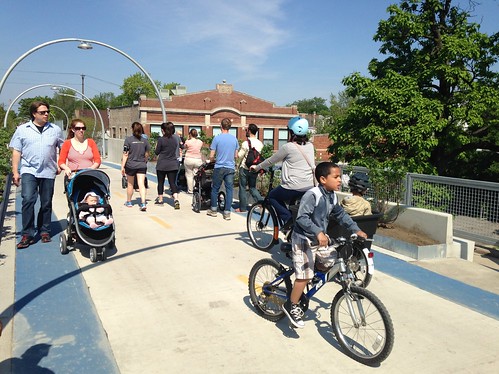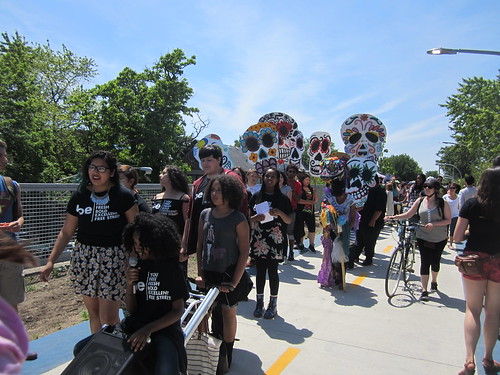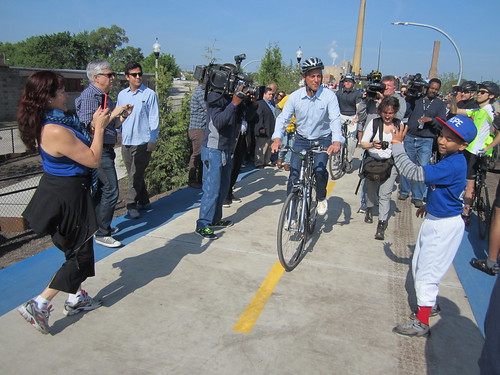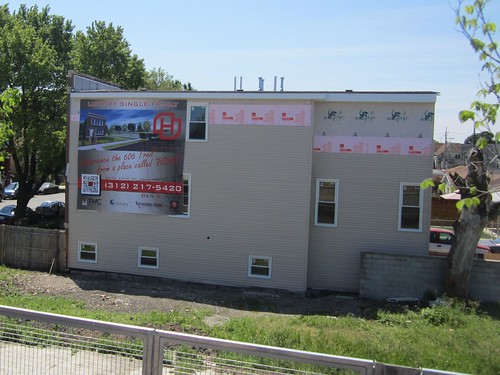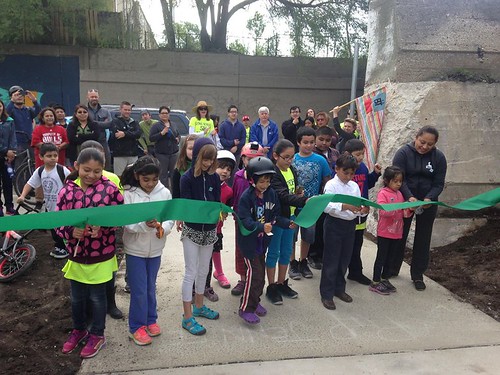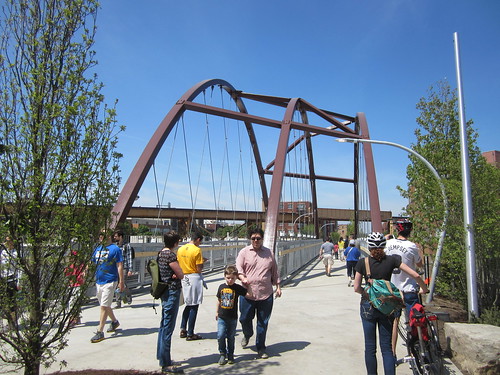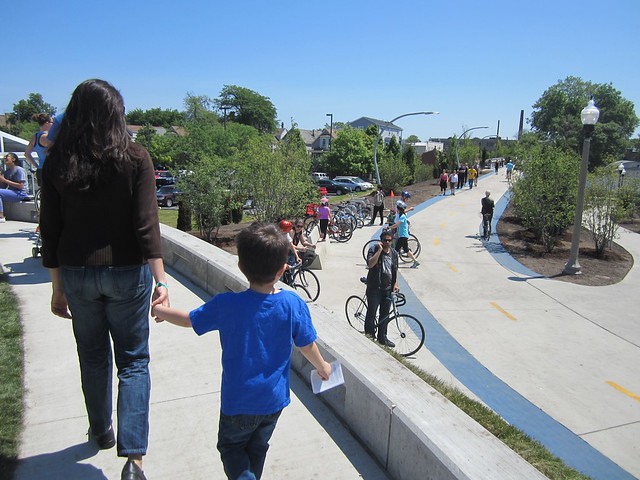In a 2009 Chicago Reader story, I noted that the best-case scenario for the Bloomingdale Trail elevated greenway would be a 2016 opening, in time for the Olympics, if then-mayor Richard M. Daley succeeded in winning the games. We all know what happened with the Olympic effort.
But here it is, only 2015, and thousands of Chicagoans of all ages and walks of life were already hanging out, strolling, jogging, biking, skating, and parading on the 2.7-mile path, last Saturday as part of the trail's joyful opening celebration on a gorgeous spring day. The rails-to-trail conversion and the construction of several adjacent access parks never would have happened without tireless advocacy and activism from neighbors, particularly the grassroots nonprofit Friends of the Bloomingdale Trail.
We also need to give some credit for the speedy delivery of the trail to current mayor Rahm Emanuel. In July of 2009, the city announced its choice of the contractor to design the trail, but when Daley left office nearly two years later, the contract still hadn’t been awarded. “The project was really creeping along,” acknowledged Chicago Department of Transportation deputy commissioner Luann Hamilton at the Saturday opening. She has been involved with discussions on converting the rail line since 1987.
After he was elected in 2011, Emanuel announced his intention to open the trail within four years, which seemed next-to-impossible at the time. However, soon after he took office, the design contract was awarded, and not long after that the city lined up $50 million in federal funding to build the $95 million project. The Trust for Public Land was recruited to manage the project and raise the additional money through private donations.
The opening was originally scheduled for fall of 2014, but the opening was pushed back after a brutal winter delayed construction. However, it was surreal to see the nearly completed path and parks filled with revelers on Saturday. “Mayor Emanuel galvanized support for the trail,” Luann said.
The Bloomingdale is still a work in progress – the east end near Ashland Avenue is largely a construction site, and unfinished handrails on the California Avenue access ramp created a potential hazard. TPL still needs to raise $20 million more to fund additional landscaping, public art, and other amenities, and Governor Bruce Rauner has frozen some of the state funding for access parks by the eastern and western trailheads.
Many residents of the largely working-class neighborhoods by the western half of the Bloomingdale have expressed concerns that, by raising property values and taxes, the trail will accelerate the process of less wealthy people being priced out of the area. The Reader, the Chicago Tribune, and RedEye, have covered the gentrification issue in depth.
You’ve also probably heard plenty of comments about the pedestrian traffic jams on the Bloomingdale during the busiest hours of the opening that made biking on the path a tricky endeavor. However, Saturday was surely far more hectic than the path will typically be. Trail-sharing issues will likely improve as people get used to the facility. Signs asking pedestrians to walk on the right side of the path and reminding cyclists to ride at slow or moderate speeds would be helpful.
However, even curmudgeons must acknowledge that the Bloomingdale is a spectacular new facility that will provide access to nature, relaxation, transportation, and healthy recreation for many, many neighbors, people from other parts of the city, and visitors. Some 80,000 people – a quarter of them children – live within a ten-minute walk of the trail, as evidenced by the multitude of cute kids in strollers and on foot, bikes, skates, and scooters last Saturday.
The day started with twelve simultaneous ribbon cuttings at the various access ramps, with 20 to 50 people at each one, many of them young children. This was followed by a massive bike parade on the trail led by West Town Bikes, featuring cycles decorated to look like a train, a unicorn, and other fanciful designs.
“[The Bloomingdale] is an alternative transportation corridor, a park, and a living work of art,” said Beth White, head of TPLs Chicago office, during the main ribbon cutting at the westernmost ramp. “That’s a pretty tall order, but I think we pulled it off.” The crowd responded with thunderous applause.
Friends of the Bloomingdale Trail president Ben Helphand noted that the rail embankment was built 100 years ago to exclude people by separating them from freight traffic, but residents have been reclaiming the dormant line for recreation for several decades. “When you go up there today, you still feel that sense of exploration,” he said. “You’re only 16 feet, 17 feet up in the air, but you see your community all around you with new eyes… I’m looking forward to the next 100 years of people exploring the Bloomingdale Trail.”
Emanuel congratulated the residents who originally pushed for the trail for never giving in and never giving up on their efforts. “This is your day, this is your park, this is your celebration,” he said. He said that, along with the riverwalk extension, the Big Marsh bike park on the Southeast Side, the renovation of Northerly Island, and a new nature preserve by Rosehill Cemetery, the Bloomingdale is part of his efforts to provide access to parks and trails for all Chicagoans.
Emanuel then strapped on a bike helmet and took a test ride on the trail. As he pushed his cycle up the ramp, a cop asked him if he rode regularly. “Yeah, I’m a big biker,” the mayor replied.
The day was packed with activities, including multiple art processions, nature activities, and craft-making sessions, as well as a street festival on Humboldt Boulevard, several blocks of which were completely pedestrianized for the occasion. Classes, demos, and concerts included a huge yoga class, capoeira bouts, a square dancing lesson, and performances by everyone from an East Indian-funk fusion band to a Puerto Rican cuatro ensemble to a jug band.
Residents I spoke to gave the Bloomingdale rave reviews. “I think this is a big, big win for the neighborhood,” said Juana Sanchez, a retiree who lives near the access ramp at Julia de Burgos Park, located between Whipple Street and Albany Avenue. “I like the beauty. I love openness and I love trees – I’m a tree hugger – and I think this is wonderful. I think this is a great venue for all races to come together and just enjoy the city.”
“The Bloomingdale Trail is great for our community,” said Ricky Flores, vice president of the Chicago Cruisers, a classic bicycle club with a mostly Puerto Rican membership, which was involved in the community input process for designing the path. The club wore t-shirts with an image of the path’s Milwaukee Avenue suspension bridge transformed into a cruiser bike. “People can really travel back and forth across the neighborhoods easily now," Flores said. "It’s faster and it’s safer.”
Javier Silva, who usually uses a wheelchair to get around, was checking out the street festival on a handcycle. “This is a beautiful event today, with lots of nice people,” he said. “I’m having a great time with my wife.” He added that the trail and its gently graded access ramps work great for people with disabilities. I asked if he’s happy the city built a fully accessible new trail and park system. “Hell yeah,” he replied.
The overwhelming success of the Bloomingdale Trail will help get more Chicagoans on bicycles, and create political momentum to build more “eight-to-eighty” bike facilities, suitable for use by everyone from kids to seniors. Hopefully, we’ll see more advocacy for on-street protected bike lanes, as well as new rails-to-trails. One such project is the New E.R.A. Trail, a Bloomingdale-like elevated greenway that may be built in Englewood. The city currently has a request for proposals out for that path.
As a scenic, car-free multiuse path, the Bloomingdale will attract similar users as the Lakefront Trail, so the next logical step is to create a low-stress route connecting the two. From downtown, you can currently ride from the lakefront along the riverwalk to Dearborn Street. At that point, you can pick up an almost-uninterrupted series of protected and buffered bike lanes that takes you all the way to Milwaukee and Elston Avenues in River West, soon to be extended northwest to Division Street and Ashland Avenue in Wicker Park.
In the near future, the city should create a low-stress route from there to the Bloomingdale’s eastern trailhead. Wood Street, located two blocks west of Ashland, already has a neighborhood greenway for several blocks, so that could be extended north to meet up with the trail.
In the longer term, the Bloomingdale may be extended east to cross the Kennedy Expressway, perhaps as part of the redevelopment of the nearby Finkl Steel plant. From there, it would be ideal if the city could create a network of eight-to-eighty bikeways east all the way to the pedestrian bridge over Lake Shore Drive that leads to North Avenue Beach. It’s exciting to ponder the possibilities.
